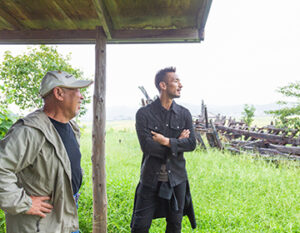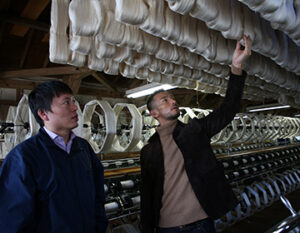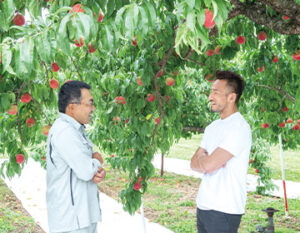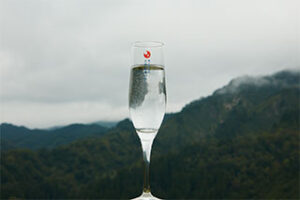Original and Mysterious, Approaching the Mystery of the Aizu Sazae-do
The “Entsu Sansodo-Hall ” (designated as a National Important Cultural Property by the Japanese government) stands on a hillside in the middle of Mt. It is a hall of wooden architecture with a height of 16.5 m and a hexagonal three-layer structure that is familiar by the name of Aizu Sazae-do. In 1796, Shoso-ji Temple, which once stood at this location, built this hall as a Kannon Hall enshrining the 33 Kannon of the Saigoku Region. It is said that if one made a round of the temple, it was believed to be as beneficial as a pilgrimage to the western part of Japan.
The 33 sacred sites of the Kannon faith are scattered throughout the Kinki region and Gifu Prefecture. It is said to be the oldest pilgrimage in Japan, and it is believed that if one makes a pilgrimage to the 33 sacred sites of the Kannon in the western part of Japan, all sins committed in this life will be extinguished and he or she will be reborn in paradise.
Hidetoshi Nakata first visited Aizu Sazae-do about six years ago. He recalls that the unique architectural style and the timeless atmosphere left a strong impression on him.
The fact that you can see all parts of the building in one-way traffic is once again an amazing structure,” he said.
Masanori Iimori, the owner of Aizu Sazaedo, nods in agreement with Nakata’s words and explains how it came to be.
There are many Buddhist temples called “sazayedo,” and it is said that the first one was Rokanji Temple in Honjo-Gotsume, Edo (present-day Oshima, Koto-ku, Tokyo), in 1728. Since then, they were built mainly in the Kanto and northern areas during the late Edo period, but only a few of them are said to still exist. The hall is characterized by a spiral passageway that circles clockwise three times.
However, the architectural style of Aizu Sazae-do is very different from the others. The hexagonal exterior is unique, but what is most unusual is the double-helix passageway, which allows visitors going up and down the aisle to pass each other without passing each other. When Mr. Nakata was told that Aizu Sazaedo is the only building in Japan to use a double-helix structure, he raised a question.


Where did he get the idea for the structure of the Sazaedo?
Mr. Iimori, who prefaced his answer by saying that he did not know the exact source, shared two hypotheses.
For generations, the Iimori family has believed that the monk Ikudo, who invented the Aizu Sazaedo, was inspired by a dream he had of a double koyori. On the other hand, there is a theory that the double spiral staircase at Chambord Castle in France, which Leonardo da Vinci is said to have been involved in designing, was the inspiration.
The “Kyoho 5 (1720) ban on Western books was lifted, and the sketches of Chambord Castle that came to the Akita clan may have been seen by the monk Ikudo. Some experts have speculated that this is so.
After ascending the passageway in a rightward direction and crossing the drum bridge at the top, the flow of visitors turns to the left. When you pass through the exit, before you know it, you are behind the building. Mr. Iimori laughs as he observes visitors curiously twisting their necks, saying, “At first, everyone is puzzled. In the Edo period (1603-1867), when the entire area of Mt. Iimori was within the precincts of Shomune-ji Temple, Iimori was not only a place for people to rest and relax, but also an object of religious worship.
Iimoriyama is often associated with the Boshin War at the end of the Edo period (1603-1868), but in fact, this site is also the remains of a posteriori burial mound built in the 4th century.
As the conversation turned to history, Mr. Nakata’s eyes lit up when he heard that there is also a wonderful historical site called Sakudari Kannon in the neighboring town of Aizu Misato. He does not seem to flinch when told that access is a bit inconvenient.
I often find more unexpected discoveries in places that are less accessible because I don’t usually go there,” he says. After all, the best part of traveling is discovering new things.













